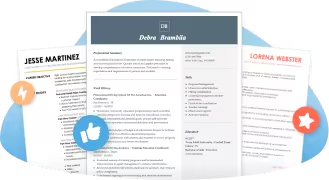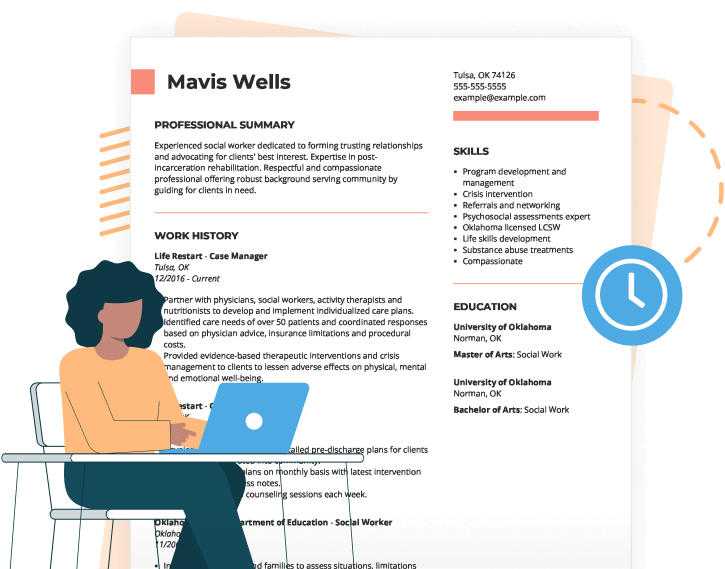Featured Resume Examples
Additional often-requested IT resume examples are for IT Project Manager, IT Manager and Technical Support. If you’re looking for a different role, scroll down, we have over a hundred more below.
Search Information Technology Jobs
Information Technology Resumes by Job Title
Find the resume example you need by browsing these specific Information Technology categories:
Construction Administrative Roles (1)
Administrator Roles (4)
Architect and Engineering Roles (2)
Assistant and Support Roles (6)
Consultant Roles (2)
Executive Roles (3)
General Tech Roles (4)
Management Roles (18)
Research and Analyst Roles (1)
Security Roles (1)
Specialist Roles (2)
Technician Roles (3)
General Maintenance Roles (1)
Procurement Roles (1)
Physical Therapy and Rehabilitation Roles (2)
Cover Letter Examples for Information Technology Jobs
Job Outlook
We live in a tech-dominated world and that’s not going to change. Employment in computer and information technology is expected to grow 11% by 2029 according to the U.S. Bureau of Labor Statistics.
Keep in mind that in order to land that ideal role for you, it’s essential that you submit a resume that helps you stand out above other job candidates.
Check out our professional writing tips below to make sure that your resume has that extra edge.
3 Tips for Writing Information Technology Resumes
Choose the right format for your resume
As you know from your work in IT — the way that you organize data means everything, and it’s no different with your resume.
The way you organize your personal information on your resume is called a resume format and there are three main kinds: chronological, functional and hybrid.
The main difference between the three formats is where the primary focus is placed, whether it’s more weighted toward your skills or toward your work history.
The one you should choose depends on how much experience you have for the tech role that you want to apply to.
Chronological formats are ideal for job candidates with five or more years of experience because they put greater focus on your work experience, what you’ve accomplished and how your career has progressed.
But if you’re fresh out of school or transferring from a different industry, you should choose a different format that better fits your level of experience.
Functional formats put greater emphasis on your skills and education which takes attention away from your inexperience. If you have less than two years’ experience in tech, this format is ideal for you.
A hybrid format is a mix of the functional and chronological formats and gives a more even balance between your work history and skills. If you’ve worked for more than two years in IT, but less than five total, make this your format.
Promote your skills
Every IT job requires its own special set of skills, however, there are some skills that are in demand across the industry.
For your resume include six-to-eight key skills that best describe what you bring to the table.
Desired IT skills include:
- Analytical thinking
- Project management
- Troubleshooting
- Communication
- Hardware installation
- Software maintenance
- Multitasking
- Cross-functional collaboration
- Process review
- Coding
- Organization
- Service management
- Creative thinking
- Problem-solving
- Attention to detail
- Computer proficiency
- Coding skills
- Beta testing
- Networking
- Software development
- Cybersecurity
- Cloud computing
- Teamwork
- Time management
- Microsoft Excel proficiency
- Information architecture
- Language expertise, eg. C++, HTML, Javascript or Python
- UX design
- Communicating complex information
- Meeting deadlines
- Remote working
- Scheduling
Study the job ad or posting with a careful eye — the keywords and phrases listed are your best indication of exactly what the position seeks in a candidate.
Show that you pay attention to details by reflecting those key skills with the same phrasing that the employer used.
Use a template to make sure your resume looks sharp
A template is a preformatted document created by a visual designer to be clear, professional, and to make writing a resume faster and easier.
You don’t have to worry about margins, headers, color schemes, or brush up on contemporary resume designs, that could take hours.
All you have to do is pick one that you like and input your personal data.
You can save it in any file format and then you’re ready to apply for jobs. It’s that simple.
JobHero has some wonderful resume templates that you can use.
Even greater, JobHero features a cutting-edge Resume Builder that allows you to choose from a selection of templates.
The biggest perk: It also automates the writing process for you and gives you suggested ways to phrase work experience based on job title resume data.
Using a Resume Builder is like having an IT expert look over your shoulder to give you a practical step-by-step walkthrough.
FAQ
How much does a job in information technology get paid?
The average annual wage for computer and information technology professionals was $88,240 in 2019 according to the U.S. Bureau of Labor Statistics.
This is much higher than the median average for all professions which is $39,810.
Which is why you should take getting the job seriously and use a Resume Builder to ensure that you present yourself in the strongest possible way.
What should I put on my resume for the information technology industry?
One of the best ways that your resume can grab the attention of employers is by including as many numbers as possible to demonstrate the work you do.
Numbers will grab the attention of hiring managers looking over your resume and give them something to latch onto that reflects the capacity of your work.
For example, a scrum master could include figures like these convey the impact and scope of their work:
Try to make the numbers you include flattering, but don’t embellish or lie about your achievements. That will backfire.
How do I list education on an information technology resume?
Most jobs in the information technology industry require advanced education.
So, it’s standard practice to include education on any resume.
The rule is to list any education you’ve had from college on.
When you include it, give the name of the school, its city/state and the degree you earned (if applicable) with your major.
It could look something like this:
Nassar College Medford, OR
BS, Information Technology
Take note: It used to be standard practice to list the year that you graduated, but not anymore.
It’s discouraged to mention dates because it gives an indication of your age. That can lead to hiring bias. Only include the dates you attended if you did not complete the degree.
If you have received vocational training to earn a scrum master certification, you should create a “licenses and certifications” section on your resume to list that information.
For more detailed information on how to include a certifications section check out our page, The Best Way to List Professional Certifications on Resumes.
What kind of work experience should I put on an information technology resume?
If possible, keep all the work experience you include in a resume centered on your IT experience.
The more your work history aligns with the position that you’re applying for, the more that managers will give you serious consideration. After all, if you could perform the duties for one company, chances are that you can do it again.
Include details about your previous roles that you believe will be useful for the position that you’re applying to for instance if the company size, product, culture or organization was similar, mention it.
However, if you’re new to the IT industry but have experience from other industries, focus your resume on the shared skills that both jobs may require. Anything involving teamwork, attention to detail, problem solving, computer skills, critical thinking or numerical data would be useful to feature.
Should I include a cover letter with my information technology resume?
Yes, it’s always in your best interest to include a cover letter with your IT resume.
For one, it’s more space that you can talk about yourself and your work achievements.
Even better, introduce yourself, and explain what motivates your passion for IT and the direction your career is going.
To help you write your own great letter, check out JobHero’s information technology cover letter examples page.
Check out how like-minded professionals have advertised their skills, and it’ll help you get inspired.
If you want more guidance, JobHero also has a step-by-step guide on how to write a cover letter that will break each section of the cover letter down for you so that you know exactly what to say.






